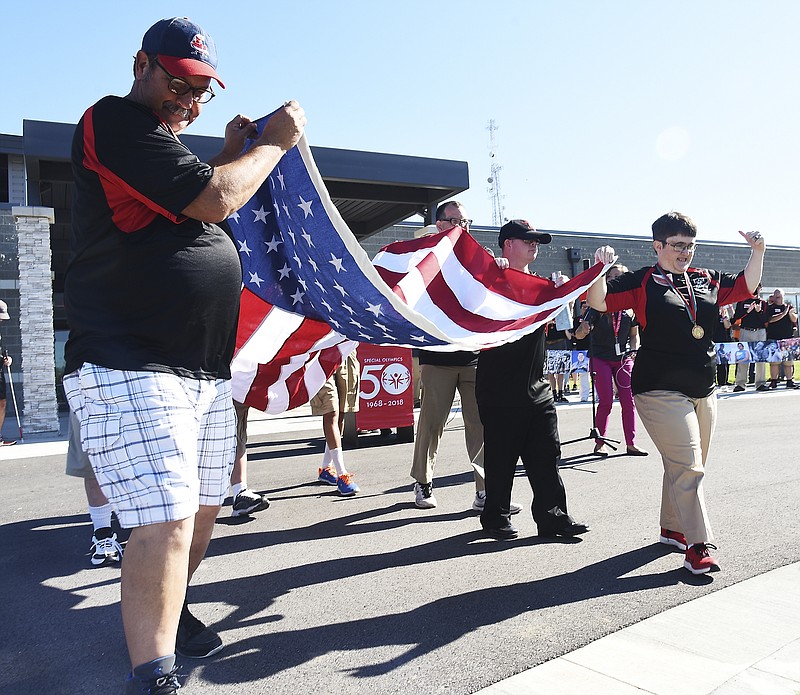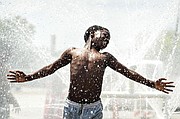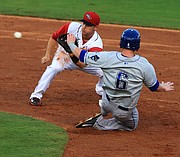It's all new, down to the street.
The Special Olympics Missouri Training for Life Campus gleams in the sun, standing in the old rock quarry site near Christy Drive and Missouri 179 on a short street with a one-of-a-kind address - 305 Special Olympics Drive.
A tall aluminum flagpole supporting a U.S. flag stands guard out front of the center of the building within a circular driveway. It is mirrored by an identical flagpole behind the building bearing a Special Olympics flag. Between is a glass, steel and stone structure designed to inspire its inhabitants.
The gem of the campus is the 32,000-square-foot structure that houses health and wellness, fitness, sports skills development, and sports leadership training centers. It also contains offices for Special Olympics Missouri and for Special Olympics Missouri-Central Region.
Paving stones outside the entrance in the center of the building, both in the front and rear, are inscribed with donors' names or messages and names of Special Olympians who raised $5,000 or more. Glass doors and walls welcome visitors who are greeted in a large atrium.
It's a hub, said Nick Borgmeyer, project manager for Simon Oswald Architecture, of Columbia, who designed the structure.
"As they come in, all the areas of the building are accessed out of here," Borgmeyer said. "You can see, everything is lined up in an axis, from flagpole - down the center - to flagpole."
A future Law Enforcement Torch Run Plaza will be located in line with the poles in what is being touted as the "Back 9."
The center is glassy and open. There's a lot of translucent glazing that catches light, Borgmeyer said. So, when people see the building from a distance, they see the center is illuminated.
The entry is topped by an arc-shaped roof that has an average height of about 23 feet. Translucent clerestory windows on the north and south sides of the hub let in natural light. And up-lights at the windows' bases provide decorative and indirect light.
"Everything has this feel of natural light and connection to the outdoor spaces," Borgmeyer said. "Since these windows on the side are translucent, they let light through, but not vision. They distribute light. It illuminates the ceiling plane pretty well without having much artificial light. So it makes the space feel very tall."
For some, it may be awe-inspiring.
"It creates that sense of grandeur. When you come in, you get that 'wow' experience," Borgmeyer said. "But it is really functional, too."
In the center of the hub is a circular desk with a circular light hanging overhead. That's the work station for Derek Sandbothe, one of the newest employees of Special Olympics Missouri. Sandbothe, the first Special Olympics athlete SOMO has hired, is the campus host. He answers phones, gives tours and assists staff.
"I love the people, the job," Sandbothe said. "The things I get to do around here - extraordinary."
There's a lot to do and see.
Designers did some things that are simple in the way an architect might think about them, Borgmeyer said. In the center of each space, the "cores of the building," there are restrooms and other functional areas.
But they also have the concrete lids on top - the roof. That's where mechanical equipment stands. Areas beneath the lids act as safe zones for severe storms.
Brandon Schatsiek, SOMO multimedia and athlete leadership manager, said the new campus takes programming for current athletes "to the next level."
There are more than 15,000 SOMO athletes, but there are also more than 106,000 people with intellectual disabilities around the state who aren't participating in Special Olympics.
"Having a campus like this that is centrally located gives us the opportunity to bring in more people to the program that may not have been involved in the first place," Schatsiek said. "It allows us to expand our reach into other parts of the state where we may be having trouble getting programs started."
The campus will host specific camps. For example, Schatsiek said, it may hold a basketball camp for a weekend. Or it may just do a St. Louis camp, where organizers will put information out into the public and advertise - not just to current clients, coaches and family members - in church bulletins or other under-utilized resources. Anyone with an intellectual disability who wants to see what Special Olympics is all about may come to this campus. SOMO won't provide transportation or housing during camps, but it will have meals catered.
"The idea is that (campers) can fundraise to come to these events," Schatsiek said.
SOMO will negotiate reduced rates with some local motels. Camps will be limited to about 25-50 participants.
SOMO accepts athletes who have intellectual disabilities from 8-108, he said. There is no upper age limit. All they need is a physical.
The Hall of Inspiration, the first hall on the left of the "City of Jefferson Lobby," acts as a sort of museum, providing some history of Special Olympics. Displays, including photographs of athletes, on the walls may easily be changed. The hall also features the Flame of Hope, where athletes and other visitors may stop to take a selfie with a decorative torch that hangs from a wall.
The hall contains photos of athletes who have won annual awards.
The area also acts as the entry lobby for the Healthy Athletes Program.
No other Special Olympics site has such a program.
The program allows the campus to provide free health screenings in seven disciplines, according to Health Partnership Manager Carol Griffin.
Special Olympics is the world's largest health organization for people with intellectual disabilities.
Allen Tobin, an athlete, said if it weren't for the organization, he wouldn't have a hearing aid, glasses or teeth.
The program contains color-coded examination rooms to help athletes identify which rooms they should be in. The color codes correspond to a health discipline. The fuchsia hearing-examination room includes a sound booth. Vision screenings are done in a blue room, dental in a purple room and medical examinations (including "fit feet") in a red-coded room.
The program has a waiting room, such as any medical office would, Griffin said, so the athletes can become familiar with waiting rooms in other health care environments.
"The reason it's so important is that a lot of our athletes - because of transportation or because of their disabilities scaring them to see doctors - don't see doctors on a regular basis," Griffin said. "So we bring the screenings to them."
Screenings are done by volunteer doctors who have received training through Special Olympics International at one of the organization's outdoor state games.
SOMO is able to offer screenings at the camps and at the games. The next level is its Health and Wellness program, she said.
That program offers nutrition and fitness education, according to Health and Wellness Manager Meagan Davis. The athletes will be able to follow up after leaving camp and continue their educations.
Lynna Hogdson, of Oak Grove, is an athlete who said she has lost 32 pounds using the program in a couple of months.
"(Clients) will have an overall, comprehensive health plan focusing on stress management, sleep and mindfulness," Davis said. "We also hope to offer in-person classes for athletes on everything from maybe a yoga/fitness class to easy, simple, healthy cooking."
The campus includes a catering kitchen that instructors plan to use for the cooking classes, she said.
When athletes come to camps, they will have scheduled times for their screenings, just like at a doctor's office, Griffin said. They arrive and check in with a receptionist at a window. Then they go back and get their screenings.
"We're trying to educate them, too - that doctors are a good thing and that you need to go visit your doctor," Griffin said.
Jefferson City will host the Missouri State Outdoor Games on Sept. 28-30. During that weekend, 1,100 athletes will participate in sports including bocce, flag football, golf, softball and tennis at venues throughout the city. Basketball and volleyball will be played in the campus arena.
"On Sept. 29, we will offer six different screenings," Griffin said. "We'll be using the rooms. We'll be using half of the arena, and we also have a 42-foot mobile unit coming."
Volunteer doctors and medical staff will be on site that day, she said.
When SOMO has games, it sends out a coach's handbook. Within the handbook, SOMO notifies coaches what screenings will be available. Coaches then share that information with their athletes.
About 300 athletes are expected to receive health screenings during the games.
A recognition of people who have received Volunteer of the Year awards stands in the Hall of Inspiration, just outside the Health and Wellness area.
Photos throughout the building relate to the athletes. Athletes may register for camps at a window in the hall. Restrooms, locker rooms and a laundry stand near the north end of the hall. The locker rooms include cubby holes where athletes can put their personal items.
"The nice thing about this is that we're really treating it like a professional training camp," Davis said. "So, when they come, they'll each have their individual names on their cubbies."
It will really be personalized.
The arena, at the far northern end of the campus structure, will host basketball and volleyball for the state games at the end of the month, Griffin said.
On Sept. 29, it will be divided in half. Half will be used for screenings. The other half will be used for a dinner for athletes.
Later that night, a dance will be held outside and Bingo will be played in the meeting rooms.
A large room (about 33 feet by 75 feet) known as the inventory depot, on the east side of the arena, houses all of SOMO's health and wellness banners, games, posters, medicine balls, clinical gloves and other items.
Some posters are used for very specific tasks.
"We might ask, 'What did you drink for breakfast?' and athletes will point to hopefully juice or something healthy and not soda," Griffin said. "But, if they point to soda, that is when we have dietitians and volunteers say, 'This would be a better choice.'"
It's about trying to educate the athletes, she said.
The area also includes a work area and office for the facilities manager.
A second north-south hallway leads from the depot to the health and center fitness center. The center includes cardio equipment for athletes - treadmills and ellipticals. It also includes free weights, exercise bands and other equipment used for power lifting, Davis said.
All the equipment is brand new, she said.
"We didn't have space to offer this before," Griffin said. "Athletes can come and use it regularly."
The Jefferson City Parks, Recreation and Forestry Department provides SOMO with coaches who can help the athletes with their training, she said.
Another hall leads back to the lobby. Stepping out the glass doors from there to the east or back side of the lobby leaves a person on a large observation deck that looks out over the majority of the property on which the building sits. The back flagpole stands on the patio in the midst of some of the personalized paving bricks.
"(The patio) worked out as a nice place for people to gather and watch their athletes as they're practicing," he said. "The Special Olympics, the statewide office, has a commanding view of the field at all times from their office windows."
The soccer/multi-use field sits just behind the building, surrounded by an oval track, with a 100-meter straight-away.
A paved half-mile trail surrounds the "Back 9," where there is room to grow the athletic offerings of the campus.
The Back 9 is a planned expansion. Personnel have been working to secure the $2 million necessary for construction of a softball field, Law Enforcement Torch Run Plaza, shot put area and golf skills area. It also will include tennis and bocce courts and horseshoe pits.
"We're about a half million away from that," Wilbers said. "I'd like to complete it this year."
Even if they don't, staff will continue to fundraise to reach the goal. SOMO organizers don't want to begin construction on the Back 9 until all the funding is available. That was a requirement SOMO set for itself when building the campus.
Following Thursday's ribbon cutting at the campus, a family was so moved it donated $50,000 toward the Back 9 and issued a challenge to other Missourians to meet their donation, Wilbers said.
A Missouri Development Finance Board Tax Credit will provide a 50-percent state tax deduction for donors until Sept. 28. Donations also will qualify for a federal deduction.
"Over the next two weeks, we're trying to find those donors who could use those," Wilbers said. "We're looking for that angel. We think there are a couple of angels out there who are really going to see the benefit. Maybe they'll tour the facility and that touches them."
The "angel" may see the campus during one of what SOMO is calling its "50 Days of Tours."
Through Nov. 1, SOMO is conducting tours of the campus and has scheduled 48 more events and tours consisting of groups ranging from 10-150 people, Schatsiek said.
Anyone wishing to donate to SOMO is asked to contact Laurie Shadoan at [email protected].
An athlete lounge sits south of the welcome desk, just off the lobby.
Special Olympics Missouri-Central Region and Special Olympics Missouri offices are arranged along the back of the building, also on the south side of the lobby.
"We have a lot of interns and volunteers, so they have an area where they can work," Griffin said.
Mid-size conference rooms stretch along the offices. Several have smart TVs so staff can teleconference with other offices or partners.
A large copy/mail room/work area gives staff the ability to "spread out" if they need.
Showering rooms are available for staff in case they want to use some of the health equipment.
The southeastern corner of the building is taken up by a caterer's kitchen, which can be accessed directly from a parking lot, and three large meeting rooms that SOMO included in their plans because people had difficulty finding large, useful meeting rooms in Jefferson City. Dividers allow the rooms to be used separately or as one large area.
People are encouraged to contact SOMO if they wish to rent the rooms.
Wilbers said 52 percent of SOMO's athletes work in the workplace, versus just 10 percent of Missouri's population of people with intellectual disabilities.
The Athlete Leadership Program provides coursework that athletes can select from and study to learn and strengthen skills. For example, Sandbothe went through the speech side to be a "global ambassador" for SOMO, Wilbers said.
So, when Sandbothe goes out, he speaks at communities.
"He doesn't know a stranger anymore," Wilbers said. "Because of the program, he has the capability to talk to anybody."



